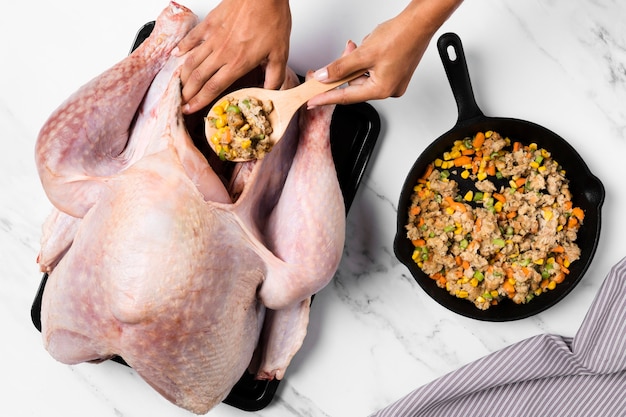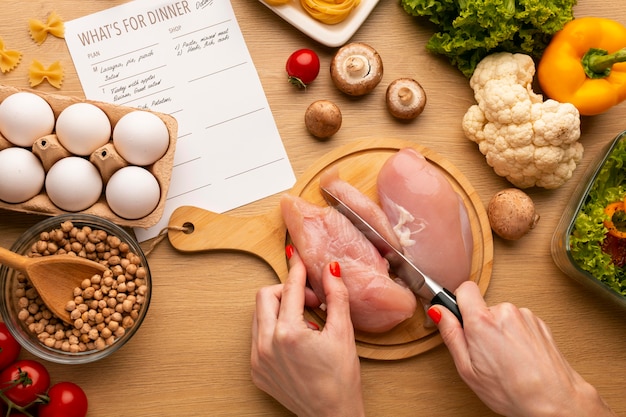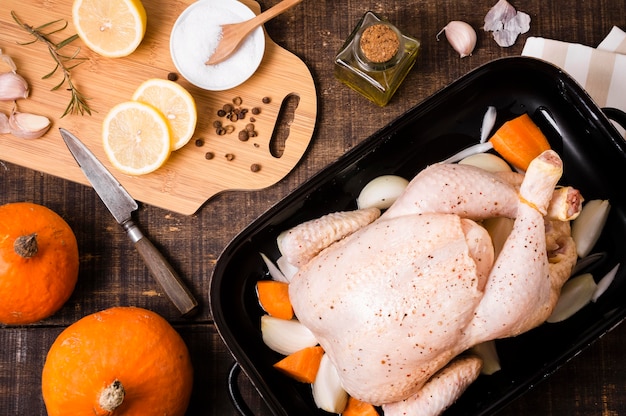Let's talk about cooking chicken, one of my absolute favourite things to do. It's versatile, tasty, and a pretty good value for money. But let's be honest, cooking chicken can be a bit of a minefield. Get it wrong, and you're looking at a potential food poisoning nightmare. I've been there – once, I served a roast chicken that wasn't quite cooked through, and let's just say the aftermath was, shall we say, "unpleasant." It was a real eye-opener. That's why, over the years, I've become obsessed with making sure I cook my chicken properly. I've learned a lot, and I'm here to share my knowledge with you, so you can avoid any dodgy chicken-related dramas.
The Golden Rule: internal temperature

(Part 1) Let's start with the basics. The most important thing when cooking chicken is to ensure it reaches a safe internal temperature. This is the only way to guarantee that any bacteria lurking about is properly killed off. We're talking about Salmonella, a nasty little bug that can cause food poisoning, leading to symptoms like nausea, vomiting, diarrhoea, and stomach cramps. No one wants to experience that, so let's make sure we're doing everything we can to avoid it.
The Magic Number: 165°F/74°C
Now, this is where it gets really important: the minimum safe internal temperature for chicken is 165°F (74°C). That's the temperature you need to reach in the thickest part of the chicken, and you need to make sure it stays at that temperature for at least 15 seconds. No ifs, no buts, no excuses. This might sound like a lot, but trust me, it's worth it.
Why Temperature Matters

(Part 2) You might be thinking, "why is temperature so important?" Well, as I mentioned before, it all comes down to bacteria, particularly Salmonella, which can be found in raw chicken. This nasty little bug can cause food poisoning, leading to symptoms like nausea, vomiting, diarrhoea, and stomach cramps. No one wants to experience that, so let's make sure we’re doing everything we can to avoid it.
Don't Rely on Colour

(Part 3) Now, here's where things get a bit tricky. You can't always rely on the colour of the chicken to tell if it's cooked through. Yes, it's true that chicken turns white when it's cooked, but sometimes it can appear white on the surface, while the inside is still pink and potentially unsafe. That's why a food thermometer is your best friend when cooking chicken. It's the only reliable way to ensure your chicken is cooked properly.
Choosing the Right Thermometer
(Part 4) If you're serious about cooking chicken, a digital instant-read thermometer is a must-have. These little gadgets are incredibly affordable, and they’ll save you from any culinary disasters. You simply stick the probe into the thickest part of the chicken, and the display will show you the internal temperature. Easy peasy! I wouldn't be without mine, it's a real game changer. There are plenty of options available, so have a look around and choose one that fits your budget and needs.
Where to Take the Temperature
(Part 5) When taking the temperature of chicken, it’s crucial to insert the thermometer into the thickest part, avoiding any bones. For whole chickens, this means taking the temperature in the thickest part of the thigh, near the bone. For chicken breasts, stick the probe into the centre of the thickest part. For chicken legs, insert the thermometer into the thickest part of the thigh, avoiding the bone. If you're unsure, just refer to the instructions that came with your thermometer. Don't be afraid to experiment a bit to find the best spot for your chicken cuts. You'll soon get the hang of it.
Don't Overcook It
(Part 6) Now, we’ve established that you need to cook chicken to a safe internal temperature, but that doesn’t mean you should overcook it. Overcooked chicken can be dry and tough, which is a real shame because chicken can be so flavourful and juicy. Aim for 165°F (74°C) and no more. Don't let the fear of undercooked chicken make you overcook it. You want to find that perfect balance of safety and deliciousness.
How to Cook Chicken to Perfection
(Part 7) Now, let’s talk about different ways to cook chicken and how to make sure it’s cooked to perfection. This is where I really get excited! It’s time to talk about some of my favourite chicken recipes.
Roast Chicken
I love a good roast chicken. It’s so simple and satisfying. The key is to make sure the chicken is cooked evenly. Start by preheating your oven to 400°F (200°C). Then, rub the chicken with some olive oil, salt, pepper, and your favourite herbs. I like to use rosemary, thyme, and garlic for a classic flavour. Place the chicken in a roasting pan and cook for about 1 hour and 15 minutes, or until the internal temperature reaches 165°F (74°C). Make sure you check the internal temperature in the thickest part of the thigh, near the bone. If you find it's still not quite cooked through, just pop it back in the oven for a few more minutes until it reaches the magic number.
grilled chicken
grilling chicken is another fantastic option. Marinate it beforehand for extra flavour. I like to use a simple marinade of olive oil, lemon juice, garlic, and herbs. You could even add a bit of honey or soy sauce for a more complex flavour profile. Preheat your grill to medium-high heat and grill the chicken for about 5-7 minutes per side, or until the internal temperature reaches 165°F (74°C). Grilling chicken is great because it gives it that lovely smoky flavour. Just make sure you keep an eye on it and don't overcook it.
pan-seared chicken
For a quick and easy weeknight meal, pan-seared chicken is the way to go. Simply heat some olive oil in a pan over medium-high heat. Season your chicken with salt, pepper, and your favourite spices. I love to use paprika, cumin, and chili powder for a bit of a kick. Sear the chicken for about 3-4 minutes per side, or until browned and cooked through. Make sure the internal temperature reaches 165°F (74°C). Pan-searing is a great way to get a crispy skin and juicy meat. You can serve it with a variety of sides like mashed potatoes, roasted vegetables, or a simple salad.
Baked Chicken
Baked chicken is a great option for a fuss-free dinner. Preheat your oven to 400°F (200°C). Place the chicken in a baking dish and bake for about 40-50 minutes, or until the internal temperature reaches 165°F (74°C). You can add vegetables to the baking dish for a complete meal. I like to add potatoes, carrots, and onions for a hearty and satisfying meal. You can also use a variety of herbs and spices to flavour the chicken and vegetables. baking chicken is a great way to make a large batch of chicken for multiple meals. You can store it in the refrigerator for up to 3-4 days and reheat it when you need it.
Safe Handling Practices: Keeping Your Chicken Safe
(Part 8) Right, we’ve covered the temperature thing, but there are a few other things you need to keep in mind when handling chicken. These are simple but essential steps that can prevent the spread of bacteria and ensure your chicken is safe to eat.
Washing Your Hands
Wash your hands thoroughly with soap and water before and after handling raw chicken. It’s a simple step but a vital one. And remember, if you’re using a cutting board, clean it thoroughly with hot soapy water after preparing the chicken. You don’t want any lingering bacteria to cross-contaminate your other food. I know it sounds obvious, but it's easy to forget when you're in a hurry. But trust me, it's worth taking a few extra seconds to wash your hands properly.
Storing Chicken Properly
Storing chicken properly is key to preventing bacterial growth. Always store raw chicken on the bottom shelf of your fridge, below other foods, to avoid any potential cross-contamination. And remember, chicken should always be refrigerated at 40°F (4°C) or below. This helps to slow down the growth of bacteria and keep your chicken safe to eat. You can also store chicken in the freezer for up to 2-3 months. Just make sure you wrap it tightly in freezer-safe wrap or foil to prevent freezer burn.
thawing chicken safely
If you’re using frozen chicken, make sure you thaw it properly. Never thaw chicken at room temperature, as this is a breeding ground for bacteria. The safest ways to thaw chicken are in the refrigerator overnight, or in a cold water bath, changing the water every 30 minutes. The refrigerator method is the safest option, as it prevents bacteria from growing rapidly. If you need to thaw chicken more quickly, the cold water bath method is a good alternative. Just make sure you keep the water cold and change it regularly.
Don’t Leave Chicken Out
Once you’ve cooked your chicken, don’t let it sit out at room temperature for too long. Bacteria can grow quickly at room temperature, so it’s best to refrigerate cooked chicken within two hours (or one hour if the temperature is above 90°F). This is a crucial step in preventing food poisoning. If you're planning a picnic or a barbecue, keep your cooked chicken in a cooler with ice packs to keep it cold. This will help to ensure that it stays safe to eat. And if you're not sure if the chicken has been out for too long, it's always better to err on the side of caution and throw it away. It's not worth risking your health.
FAQs
(Part 9) Let's get to your burning questions. I’ve been there, so I’ve compiled a list of the most common questions about chicken safety. Let’s dive in.
1. Can I Reheat Chicken More Than Once?
In a nutshell, no. Reheating chicken more than once can increase the risk of food poisoning. The bacteria in chicken can survive even when heated, and reheating multiple times can create an environment where they thrive. So, it’s best to only reheat chicken once. You can reheat chicken in the oven, microwave, or stovetop. Just make sure you heat it to an internal temperature of 165°F (74°C) before serving. If you're not sure if the chicken is properly reheated, it's always best to err on the side of caution and throw it away.
2. Is it Safe to Eat Chicken with Pink Inside?
Absolutely not. Just because the chicken looks white on the outside doesn't mean it's safe. Chicken needs to be cooked to an internal temperature of 165°F (74°C) to kill bacteria. If you see pink inside, it means the chicken isn't cooked through and needs to be cooked more. Don't be tempted to eat it just because it looks "almost done." It's not worth the risk of food poisoning. Always use a food thermometer to make sure your chicken is cooked through, even if it looks white on the outside.
3. Can I Marinate Chicken at Room Temperature?
No, never marinate chicken at room temperature. Bacteria can grow rapidly in this environment, increasing the risk of food poisoning. It’s best to marinate chicken in the refrigerator for a few hours, or even overnight. Marinating chicken in the refrigerator is a safe way to add flavor and moisture to your chicken. Just make sure you keep it covered and store it on a plate or in a container to prevent cross-contamination.
4. Can I Freeze Cooked Chicken?
You certainly can. Cooked chicken can be frozen safely for up to 3-4 months. Just make sure you wrap it well in freezer-safe wrap or foil to prevent freezer burn. Freezing cooked chicken is a great way to save time and money. You can freeze it in individual portions or as a whole. Just make sure you label it with the date so you know when it was frozen. When you're ready to use the frozen chicken, you can thaw it in the refrigerator overnight or in the microwave. Just make sure you reheat it to an internal temperature of 165°F (74°C) before serving.
5. How Long Can I Leave Cooked Chicken Out Before It's Not Safe?
Cooked chicken should be refrigerated within two hours (or one hour if the temperature is above 90°F). It's crucial to remember that bacteria can grow quickly at room temperature, so it’s best to play it safe and refrigerate it as soon as possible. If you're not sure if the chicken has been out for too long, it's always better to err on the side of caution and throw it away. It's not worth risking your health. And if you're planning a picnic or a barbecue, keep your cooked chicken in a cooler with ice packs to keep it cold. This will help to ensure that it stays safe to eat.
A Final Word
(Part 10) Cooking chicken doesn’t have to be stressful. Remember the golden rule: cook it to a safe internal temperature of 165°F (74°C) and handle it with care. With a little bit of knowledge and a few simple tips, you can enjoy delicious and safe chicken meals every time. Happy cooking!
Everyone is watching

Perfect Rice Every Time: The Ultimate Guide to Cooking Rice
Cooking TipsAs a self-proclaimed foodie, I've always been a bit obsessed with rice. It's the foundation of countless cuisi...

Prime Rib Roast Cooking Time Chart: Per Pound Guide
Cooking TipsPrime rib roast. Just the name conjures images of lavish dinners, crackling fires, and hearty laughter. It’s ...

The Ultimate Guide to Cooking Asparagus: Tips, Techniques, and Recipes
Cooking TipsAsparagus. The mere mention of this spring delicacy conjures up images of vibrant green spears, crisp and burs...

Ultimate Guide to Cooking the Perfect Thanksgiving Turkey
Cooking TipsThanksgiving. Just the word conjures up images of overflowing tables laden with delicious food, the scent of r...

How Long to Bake Potatoes in the Oven (Perfect Every Time)
Cooking TipsBaked potatoes are a staple in my kitchen. They're incredibly versatile, delicious, and surprisingly easy to m...
